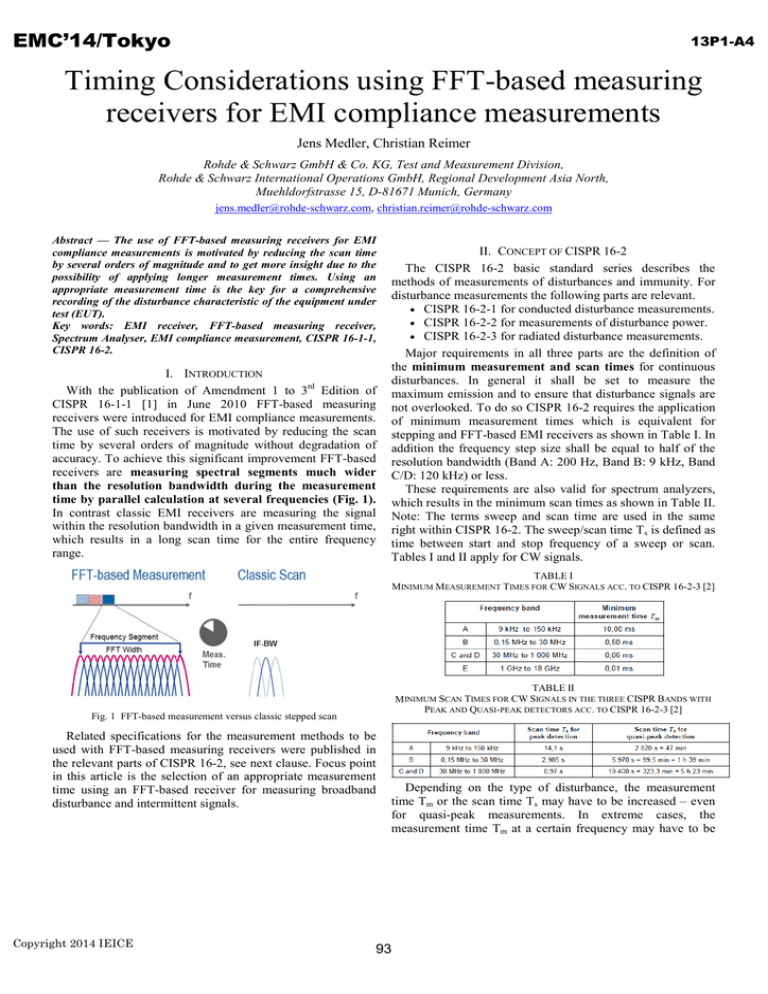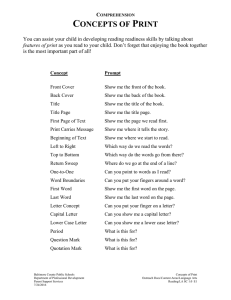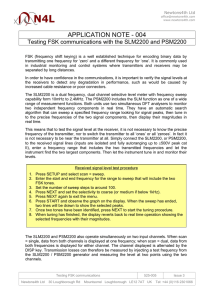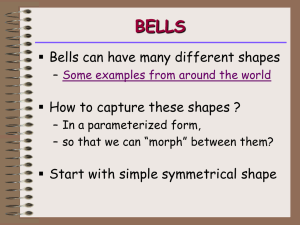13P1-A4. Timing Considerations using FFT
advertisement

EMC’14/Tokyo 13P1-A4 Timing Considerations using FFT-based measuring receivers for EMI compliance measurements Jens Medler, Christian Reimer Rohde & Schwarz GmbH & Co. KG, Test and Measurement Division, Rohde & Schwarz International Operations GmbH, Regional Development Asia North, Muehldorfstrasse 15, D-81671 Munich, Germany jens.medler@rohde-schwarz.com, christian.reimer@rohde-schwarz.com Abstract — The use of FFT-based measuring receivers for EMI compliance measurements is motivated by reducing the scan time by several orders of magnitude and to get more insight due to the possibility of applying longer measurement times. Using an appropriate measurement time is the key for a comprehensive recording of the disturbance characteristic of the equipment under test (EUT). Key words: EMI receiver, FFT-based measuring receiver, Spectrum Analyser, EMI compliance measurement, CISPR 16-1-1, CISPR 16-2. I. INTRODUCTION With the publication of Amendment 1 to 3rd Edition of CISPR 16-1-1 [1] in June 2010 FFT-based measuring receivers were introduced for EMI compliance measurements. The use of such receivers is motivated by reducing the scan time by several orders of magnitude without degradation of accuracy. To achieve this significant improvement FFT-based receivers are measuring spectral segments much wider than the resolution bandwidth during the measurement time by parallel calculation at several frequencies (Fig. 1). In contrast classic EMI receivers are measuring the signal within the resolution bandwidth in a given measurement time, which results in a long scan time for the entire frequency range. II. CONCEPT OF CISPR 16-2 The CISPR 16-2 basic standard series describes the methods of measurements of disturbances and immunity. For disturbance measurements the following parts are relevant. • CISPR 16-2-1 for conducted disturbance measurements. • CISPR 16-2-2 for measurements of disturbance power. • CISPR 16-2-3 for radiated disturbance measurements. Major requirements in all three parts are the definition of the minimum measurement and scan times for continuous disturbances. In general it shall be set to measure the maximum emission and to ensure that disturbance signals are not overlooked. To do so CISPR 16-2 requires the application of minimum measurement times which is equivalent for stepping and FFT-based EMI receivers as shown in Table I. In addition the frequency step size shall be equal to half of the resolution bandwidth (Band A: 200 Hz, Band B: 9 kHz, Band C/D: 120 kHz) or less. These requirements are also valid for spectrum analyzers, which results in the minimum scan times as shown in Table II. Note: The terms sweep and scan time are used in the same right within CISPR 16-2. The sweep/scan time Ts is defined as time between start and stop frequency of a sweep or scan. Tables I and II apply for CW signals. TABLE I MINIMUM MEASUREMENT TIMES FOR CW SIGNALS ACC. TO CISPR 16-2-3 [2] TABLE II MINIMUM SCAN TIMES FOR CW SIGNALS IN THE THREE CISPR BANDS WITH PEAK AND QUASI-PEAK DETECTORS ACC. TO CISPR 16-2-3 [2] Fig. 1 FFT-based measurement versus classic stepped scan Related specifications for the measurement methods to be used with FFT-based measuring receivers were published in the relevant parts of CISPR 16-2, see next clause. Focus point in this article is the selection of an appropriate measurement time using an FFT-based receiver for measuring broadband disturbance and intermittent signals. Copyright 2014 IEICE Depending on the type of disturbance, the measurement time Tm or the scan time Ts may have to be increased – even for quasi-peak measurements. In extreme cases, the measurement time Tm at a certain frequency may have to be 93 EMC’14/Tokyo 13P1-A4 increased to 15 s, if the level of the observed emission is not steady. The used measurement time for stepping and FFT-based measuring receivers and the used sweep time for spectrum analyzers is the key to ensure that disturbance signals are not missed during automatic scans or sweeps over frequency spans. Therefore, a timing analysis of the EUT disturbance characteristic has to be performed before doing automated measurements (Fig.2). Next, select a frequency of interest and switch to Zero Span mode to analyse the signal in the time domain. The example in Fig. 4 shows an interval between pulses of 20 ms. Fig. 4 Zero span measurement in spectrum analyzer mode shows a pulse interval of 20 ms; EUT: touch dimmer of halogen lamp For automated measurements two cases have to be considered: single and multiple scans or sweeps. Fig. 2 Analysis steps for automated or semi-automated measurements To demonstrate such timing analysis, a dimmer of a halogen lamp was measured using the Spectrum Analyser Zero-span mode. As an alternative an oscilloscope may be connected to the receiver’s IF output. First an overview measurement with Peak detector was performed with maximum hold to find critical frequencies for the timing analysis. It is essential to use a sufficient number of sweep points and a long sweep time >15 s. For CISPR Band B (150 kHz to 30 MHz) around 6000 sweep points are sufficient, which corresponds to a step size of about half of the resolution bandwidth. The thick trace in Fig. 3 is a good indication that intermittent signals exists. As long as the spectrums display changes, there may still be intermittent signals to discover. A. Single scans or sweeps For a single scan or sweep the measurement time at each frequency must be larger than the intervals between pulses for intermittent signals. If the measurement or sweep time is too short erroneous measurement results will be obtained. B. Multiple scans or sweeps For doing multiple sweeps with maximum hold the observation time at each frequency need to be sufficient for intercepting intermittent signals, i.e. the observation time has to be selected according to the pulse repetition interval of the disturbance signals (see timing analysis above). If the sweep time per sweep is chosen too fast the probability of intercepts per sweep is very low and erroneous measurement results will be obtained, see Fig. 5. Increasing the sweep time per sweep gives a higher probability of intercept, see Fig. 6. Fig. 3 Frequency sweep in spectrum analyzer mode; sweep time > 15 sec; around 6,000 sweep points; EUT: touch dimmer of halogen lamp Copyright 2014 IEICE Fig. 5 Visualization of Interceptions – Low probability of intercept per sweep using very high sweep rate 94 EMC’14/Tokyo 13P1-A4 where Tm is the measurement time for each segment, and Nseg is the number of seegments FFT-based measuring receivvers have to meet the general requirements on the minimum measurement m time and step size as defined in CISPR 16-2, see s clause II. Therefore, the measurement time Tm is to be selected longer than the pulse repetition interval for a correctt measurement of a broadband spectrum. If the measurement time t is to short it can result in enormous measurement result errors. e In a worst case the FFTbased measuring receiver mayy not capture the disturbance signal at all. This is in particularr fatal if the segment size has a large width, e.g. 30 MHz or morre. Fig. 6 Visualization of Interceptions – High probabbility of intercept per sweep using lower sweep rate In all cases the fastest possible sweep time per sweep is the multiplicative inverse of the resollution bandwidth based on a step size 0,5 x RBW, e.g. 194 ms for RBW=100 kHz over the frequency range 30 to 1000 MHz. M III. TIMING CONSIDERATIONS USING FFT-BASED B MEASURING INSTRUMENTS Today’s FFT-based measuring receivers are limited by the currently available analog to digital convertters (ADC), e.g. for a 1 GHz measuring receiver an ADC is neccessary with 2 GS/s sampling rate to meet the Nyquist criterrion. Furthermore, preselection filters and high resolution AD DCs, e.g. 16-bit for 30 MHz FFT-bandwidth are necessary to meet m the CISPR 161-1 overload requirements for quasi-peak detection. d Therefore, todays FFT-based receivers cannot samplee and evaluate the entire CISPR Bands C/D (30 to 1000 MH Hz) and E (1 to 18 GHz) in one shot. Instead they com mbine the parallel calculation at N frequencies and a steppped scan. For this purpose the frequency range of interest is subdivided into several segments that are measured sequentiially, see Fig. 7. IV. FAST SWEEP VERSUS FAST TIME-DOMAIN SCAN For demonstration the same EUT was used: touch dimmer of halogen lamp. Also the freequency span was reduced to 5 MHz for a better visualizatiion. First a single fast sweep without sweep time adjustment (sweep time SWT = 20 ms) was performed. It can be seen that the result does not match with the spectrum envelope at all a (Fig. 8). Fig. 8 Spectrum Analyzer – Single sw weep without sweep time adjustment does not match with the spectrum s envelope at all Next a single sweep with sweeep time adjustment based on the timing analysis above was performed; p it results in a sweep time of 20 s (20 ms pulse interrval x 1000 sweep points). The result in Fig. 9 shows a good maatch with the envelope. Fig. 7 FFT scan in sequence, Source: CISP PR 16-2-3 [2] The scan time Tscan is calculated as: Tscan = Tm Nseg Copyright 2014 IEICE Fig. 9 Spectrum Analyzer – Single sweeep with sweep time adjustment based on timing analysis of EUT: toouch dimmer of halogen lamp (1) 95 EMC’14/Tokyo 13P1-A4 If the pulse repetition interval is unknown, quite a lot of users performing multiple sweeps with fast sweep times using maximum hold function to determine the spectrum envelope. For low repetition impulsive signals, many sweeps will be necessary to fill up the spectrum envelope of the broadband component. The correct sweep time can also be determined by increasing it until the difference between maximum hold and clear/write displays is below e.g. 2 dB. For demonstration a multiple sweep with sweep time adjustment based on the timing analysis above was performed; it results in a total observation time of 20 s for 20 sweeps (20 x SWT = 1 s x 20 ms pulse interval x 1000 sweep points). But the result in Fig. 10 shows that critical frequencies are still missed! For this EUT a SWT = 2 s for 20 sweeps gives a good match with the envelope. TABLE III MATCH WITH ENVELOPE VERSUS SCAN TIME V. MORE SPEED WITH TIME-DOMAIN SCAN FFT-based measuring receivers can deliver measurement speed a few thousand times faster than can be achieved in conventional, stepped frequency scan mode. As a consequence frequency scans in the CISPR bands using the peak detector can be performed in just a few milliseconds and even with quasi-peak and average detector it takes just seconds which makes preview measurements with peak detector obsolete, see Fig. 12. Fig. 12 Analysis steps for automated or semi-automated measurements with FFT-based measuring receiver Fig. 10 Spectrum Analyzer – Multiple sweep (20x) with sweep time adjustment based on timing analysis of EUT Finally a Time-Domain Scan with measurement time adjustment based on the timing analysis above was performed. An FFT-based measuring receiver with 30 MHz segment size can measure the CISPR Band B (150 kHz to 30 MHz) in one shot. According to Equation 1 it results in a pure scan time of 20 ms, in reality a high performance receiver can present the result in about 100 ms. The achieved curve is a full match with the envelope, see Fig. 11. An overall comparison of the different approaches shows Table 3. The ultra-fast measurement speed is particular useful if the equipment under test can be operated only during a short period of time, e.g. a starter motor in cars. A part of the time saving can also be used for applying longer measurement times in order to reliably detect narrowband intermittent signals or isolated pulses. VI. CONCLUSIONS FFT-based measuring receivers can be used for EMI compliance measurements in accordance with Amendment 1 to 3rd Edition of CISPR 16-1-1. The use of FFT-based measuring receivers is motivated by reducing the scan time by several orders of magnitude without losing accuracy and to get more insight due to the possibility for applying longer measurement times. As another benefit, it can measure the disturbance spectrum with the final detector directly, which makes the measurement of fluctuating disturbances more reliable. For precise and reproducible measurements the use of an appropriate measurement or sweep time based on a timing analysis of the EUTs disturbance characteristic is essential. REFERENCES [1] [2] Fig. 11 FFT-based Receiver – Time-Domain measurement with measurement time adjustment based on timing analysis of EUT Copyright 2014 IEICE 96 Amendment 1:2010-06 to CISPR 16-1-1:2010-01 (Edition 3) Specification for radio disturbance and immunity measuring apparatus and methods – Part 1-1: Radio disturbance and immunity measuring apparatus – Measuring apparatus Amendment 1:2010-06 to CISPR 16-2-3:2010-04 (Edition 3) Specification for radio disturbance and immunity measuring apparatus and methods – Part 2-3: Methods of measurement of disturbances and immunity – Radiated disturbance measurements


